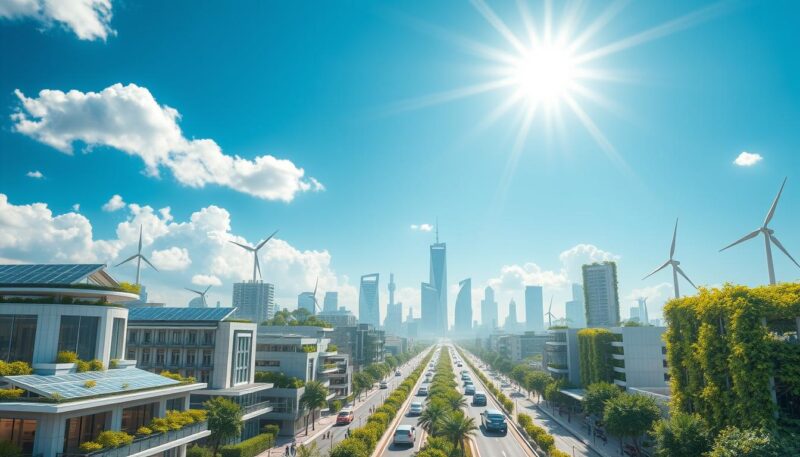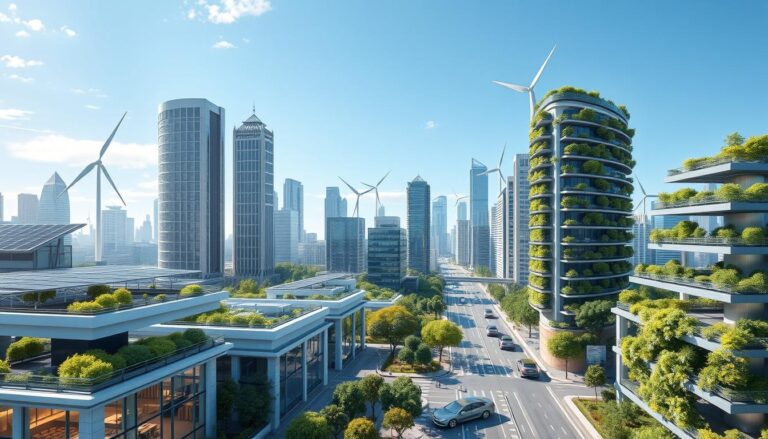As the world grapples with the escalating impacts of climate change and dwindling fossil fuel reserves, the emergence of Innovative Green Energy Technologies offers a beacon of hope. These advancements are positioned to reshape how we harness, generate, and consume energy, paving the way toward a cleaner, more sustainable future. With the International Energy Agency (IEA) reporting that three-quarters of the additional renewable capacity installed in 2023 was derived from solar photovoltaic (PV) technology, it is evident that renewable energy innovations are gaining momentum. Imagine a world where solar-powered trains can export up to 75% of their generated energy back to the grid, or where advanced lithium-glass batteries embrace aging while boasting double the energy density of traditional lithium-ion batteries.
The fascinating world of green energy technologies stretches far and wide, involving everything from food waste recycling, which contributes to 6% of global greenhouse gas emissions, to groundbreaking solar 3.0 solutions that utilize perovskites—operating with an astonishing reduction in material usage compared to conventional crystalline silicon cells. Festivals of innovation are taking place across the globe, and you can be a part of this exhilarating journey toward the future of clean energy. As habitats are rapidly being reimagined with architectural designs inspired by termites, achieving up to 90% passive climate control, it becomes clear that the quest for environmentally friendly solutions thrives on creativity and ingenuity.
In this exciting exploration of green technology, you will discover how each innovation contributes to a robust renewable energy landscape while addressing pressing environmental challenges. The promise of advanced energy storage solutions, digital twins for optimizing renewable systems, and artificial intelligence in energy management symbolizes a collective shift toward efficient and sustainable practices, consolidating the foundation for an eco-friendly future. Together, we will unearth the intricate details of these technologies and their potential to not only fuel our societies but also heal the planet.
The Role of Innovative Green Energy Technologies in the Renewable Energy Revolution
Innovative green energy technologies are at the forefront of the renewable energy revolution, shaping how we interact with various energy sources. By enhancing our understanding and implementation of Renewable Energy Sources, we pave the way for a more sustainable future. Transitioning to Clean Energy Solutions is essential as fossil fuels currently dominate global energy production. In fact, over 80 percent of global energy still comes from these unsustainable sources, contributing significantly to greenhouse gas emissions.
Understanding Renewable Energy Sources
Renewable Energy Sources such as solar, wind, and hydroelectric power are increasingly vital in the global energy mix. As of now, about 29 percent of the world’s electricity is produced from renewable sources. The advancements in solar power technology have resulted in an 85 percent reduction in electricity costs over the past decade. With projections indicating that 90 percent of global electricity could be sourced from renewables by 2050, it becomes clear that harnessing these technologies is imperative for a cleaner planet.
The Importance of Transitioning to Clean Energy Solutions
Transitioning to Clean Energy Solutions is not only a matter of sustainability but also a critical necessity for mitigating climate change. Fossil fuels account for nearly 90 percent of carbon dioxide emissions, with reductions needed to nearly half by 2030. The economic costs associated with air pollution from fossil fuels in 2018 reached $2.9 trillion, underscoring the urgency for change. Shifting towards renewable energy could decarbonize as much as 90 percent of the power sector by 2050.
Key Trends Shaping the Future of Renewable Energy
Several key trends are currently shaping the Future of Renewable Energy. Significant reductions in costs for offshore and onshore wind energy and advancements in energy storage technologies are driving increased adoption. Innovations in floating solar panels utilize water surfaces, conserving land and optimizing efficiency. Additionally, investments in renewables create three times more jobs compared to fossil fuel investments, projecting a net gain of 9 million jobs by 2030 as the industry continues to expand.
| Energy Source | Current Percentage of Global Electricity | Projected Percentage by 2050 |
|---|---|---|
| Renewable Sources | 29% | 90% |
| Fossil Fuels | 80% | 10% |
| Nuclear | Not Specified | Varies |
Breakthrough Technologies Driving the Future of Clean Energy
A variety of breakthrough technologies play a vital role in shaping the future of clean energy. These innovations are not only enhancing efficiency but also promoting sustainability across various sectors. By leveraging emerging technologies, industries are finding ways to address the challenges of climate change and optimize energy usage.
Artificial Intelligence in Energy Management
Artificial Intelligence in Energy Management is transforming how energy producers and consumers interact with resources. AI tools are designed to analyze vast amounts of data, allowing for superior forecasting and optimization of energy generation. Companies like Iberdrola and RWE have actively adopted these tools to boost renewable energy output while minimizing waste. As AI technologies continue to improve, their integration into energy systems could lead to substantial reductions in greenhouse gas emissions.
Predictive Maintenance for Sustainable Infrastructure
Predictive maintenance is essential for maintaining sustainable infrastructure in energy sectors, especially in wind energy. By utilizing real-time data analysis, companies can monitor equipment health and prevent unplanned downtimes. This proactive approach reduces maintenance costs and enhances operational efficiency, ultimately sustaining the performance of critical energy systems.
Advanced Energy Storage Solutions
The need for advanced energy storage solutions is more pressing than ever. Innovations like lithium-ion and sodium-ion batteries enable efficient energy management, helping to stabilize the grid and balance intermittent renewable energy flows. These technologies not only enhance the reliability of renewable sources but also provide the framework necessary for a fully integrated clean energy market.
Digital Twins for Optimizing Renewable Energy Systems
Digital twins are revolutionizing the optimization of renewable energy systems. By creating virtual models of physical assets, stakeholders can simulate and analyze real-time performance, allowing for better decision-making during both design and operational phases. This technology serves as a critical tool in enhancing the efficiency of energy systems, paving the way for a more sustainable future.

| Technology | Benefits | Examples |
|---|---|---|
| Artificial Intelligence | Optimizes energy management and forecasting | Iberdrola, RWE |
| Predictive Maintenance | Improves operational efficiency and reduces costs | Wind energy infrastructure |
| Advanced Energy Storage | Stabilizes grid and manages renewable energy flows | Lithium-ion, Sodium-ion batteries |
| Digital Twins | Enhances decision-making and performance analysis | Virtual models of renewable systems |
Conclusion
The future of innovative green energy technologies is bright, as these advancements continue to reshape how you think about clean energy and sustainability. As we stand on the brink of a renewable energy revolution, it’s crucial to recognize the roles that breakthrough technologies play in addressing significant challenges like scalability and intermittency. Tools such as artificial intelligence, predictive maintenance, advanced energy storage solutions, and digital twins are not just enhancing efficiency; they are paving the way for a more resilient and reliable energy infrastructure.
Your engagement with these innovative renewable power solutions is vital in the ongoing transformation toward sustainable energy. With exciting developments like the increasing blade lengths of offshore wind turbines, the efficiency of bladeless wind technology, and the initiatives by companies like Tesla and Ørsted, you can witness firsthand the tangible benefits these technologies bring. These advancements not only enhance energy production but also contribute to overall economic growth and support global sustainability goals.
As you consider the potential of the future green power technologies, it’s clear that your commitment to these advancements will help shape a cleaner and greener world for generations to come. By staying informed and involved, you can be a part of this momentum toward a sustainable future, realizing the profound impact that our collective efforts will have on the energy landscape.

